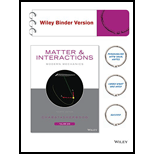
The statement which is correct to explain why car or train is not used to illustrate Newton’s laws in outer space.
Answer to Problem 1Q
Option (1).
Explanation of Solution
According to theory of relativity an object have different speed in different frames of references. For example consider an observer observes a car in one frame of reference, and another observer observes car in a different frame of reference. The speed of the car is is different for different observers. Thus a car or train have different speed in different frame of references.
But in case of spaceship, the speed of the spaceship is equal to the speed of the light for all observers.
Conclusion:
Car and train has different speed in different frame of reference, and they cannot move with the speed of the light. Car and train interact with other objects, thus speed of car and train is less than the speed of the spaceship. Hence first statement is true.
Since the spaceship moves with the
Since the speed of the spaceship remains same when it moves around any planet, it will not interact with any object until crosses the orbital speed. Thus statement three is correct.
When a car or train placed outer space, there is no attraction from Earth’s gravitation field, sine the Earth’s gravity at outer space is zero. Hence statement four is incorrect.
Since the spaceship is away from the surface of Earth, it experience less gravitational force. When the spaceship moves away from Earth the gravitational attraction decreases. The spaceship experience less gravitational force.
Want to see more full solutions like this?
Chapter 1 Solutions
Matter & Interactions
 College PhysicsPhysicsISBN:9781305952300Author:Raymond A. Serway, Chris VuillePublisher:Cengage Learning
College PhysicsPhysicsISBN:9781305952300Author:Raymond A. Serway, Chris VuillePublisher:Cengage Learning University Physics (14th Edition)PhysicsISBN:9780133969290Author:Hugh D. Young, Roger A. FreedmanPublisher:PEARSON
University Physics (14th Edition)PhysicsISBN:9780133969290Author:Hugh D. Young, Roger A. FreedmanPublisher:PEARSON Introduction To Quantum MechanicsPhysicsISBN:9781107189638Author:Griffiths, David J., Schroeter, Darrell F.Publisher:Cambridge University Press
Introduction To Quantum MechanicsPhysicsISBN:9781107189638Author:Griffiths, David J., Schroeter, Darrell F.Publisher:Cambridge University Press Physics for Scientists and EngineersPhysicsISBN:9781337553278Author:Raymond A. Serway, John W. JewettPublisher:Cengage Learning
Physics for Scientists and EngineersPhysicsISBN:9781337553278Author:Raymond A. Serway, John W. JewettPublisher:Cengage Learning Lecture- Tutorials for Introductory AstronomyPhysicsISBN:9780321820464Author:Edward E. Prather, Tim P. Slater, Jeff P. Adams, Gina BrissendenPublisher:Addison-Wesley
Lecture- Tutorials for Introductory AstronomyPhysicsISBN:9780321820464Author:Edward E. Prather, Tim P. Slater, Jeff P. Adams, Gina BrissendenPublisher:Addison-Wesley College Physics: A Strategic Approach (4th Editio...PhysicsISBN:9780134609034Author:Randall D. Knight (Professor Emeritus), Brian Jones, Stuart FieldPublisher:PEARSON
College Physics: A Strategic Approach (4th Editio...PhysicsISBN:9780134609034Author:Randall D. Knight (Professor Emeritus), Brian Jones, Stuart FieldPublisher:PEARSON





